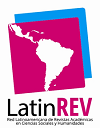Una mirada “escapista” de la sociología convencional aplicada al derecho: la Teoría del Actor Red y el mundo jurídico.
Abstract
This paper aims to apply a recent theory born in the Social Science Studies vein, the Actor Network Theory (ANT). The paper is based in a socio legal case study: the oil labelling obligation in the 1940. Mapping controversies, it tends to describe the network built by a group of scientist- state officials of Santa Fe province in their struggle to impose discriminate labelling rules. It identifies and tells the different alliances set up with other groups to associate hostile forces to the net. The paper studies how they manage to stabilize the network within the province, and how, when the network spreads beyond their translation and simplification strategies, the associated entities could not be kept together anymore. The concept of network allows to equal social elements with any other entity (natural, legal, etc). When applied to legal closure processes, the use of this theoretical approach can open a new perspective to understand the legal regulation “success” or “failure” in controversial matters.
Downloads
References
Abiusso, N. (1981) Sociedad Científica Argentina. Evolución de las Ciencias en la República Argentina (1923- 1972) Tomo IX, Química.
Babini, J. (1949) Historia de la ciencia argentina. Fondo de cultura económica, México.
Callon, M. (1998), “El proceso de construcción de la sociedad. El estudio de la tecnología como herramienta del análisis sociológico”, en Doménech, M. y Tirado, F.(eds.), Sociología simétrica. Ensayos sobre ciencia, tecnología y sociedad, Barcelona, Gedisa.
Callon, M. (1999), “Algunos elementos para una sociología de la traducción: la domesticación de las vieiras y los pescadores de la bahía de St. Brieuc”, en Iranzo et alii: Sociología de la ciencia y la Tecnología. Madrid.
Callon, Michel (2001), Redes tecnoeconómicas e irreversibilidad, REDES Nº 17, pp. 85-126.
Callon, M. (2006) Luchas y negociaciones para definir qué es y qué no es problemático. La socio- lógica de la traducción. Revista Redes, Vol. 12, N° 23, Buenos Aires, pp. 105- 128.
Francia, A. (1980) “Mullor y la ciencia como ordenamiento”, Diario El Litoral, Santa Fe, 24/03/1980, p. 20.
Hugues, T. (1983) Networks of power: electrification in Western Society, 1880-1930, Jhon Hopkins University Press, Baltimore.
Hughes, T. P. (1996), El impulso tecnológico, en Marx, Leo y Roe Smith, Merrit (eds.): Historia y determinismo tecnológico, Alianza, Madrid pp. 117-130.
Irigoyen Freyre, A. (1944) Código bromatológico. La función del Estado en la sanidad alimenticia. Imprenta de la UNL, Santa Fe.
Latour, B. (1987) Science in Action: How to Follow Scientists and Engineers Through Society. Milton Keynes, Open University Press.
Latour, B. (1988) "Mixing humans and nonhumans together: The sociology of a door-closer." Social Problems 35(3): 298-310.
Latour, B. (1999), “Give me a laboratory and I will raise the world”, en Biagioli, Mario (ed.), The science studies reader, Nueva York, Routledge.
Latour, B. (2007) “Nunca fuimos modernos. Ensayos de antropología simétrica”. Siglo XXI Editores, Buenos Aires.
Latour, B. (2008): “Reensamblar lo social. Una introducción a la teoría del actor-red”. Manantial, Buenos Aires.
Latour, B. y Woolgar, S. (1995): “La vida de Laboratorio. La construcción de hechos científicos”. Madrid, Alianza.
Law, J. (1987), “Technology and heterogeneous engineering: the case of Portuguese expansion”, en Bijker, W.; T. Hughes y T. Pinch (eds.). The social construction of technical systems: new directions in the sociology and history of technology, Cambridge, MIT Press.
Law, J. (1992). "Notes on the Theory of the Actor-Network: Ordering, Strategy and Heterogeneity." Systems Practice 5: 379-393.
Law, J. (1999). After ANT: Topology, Naming and Complexity. In J. Law and J. Hassard (Eds.) Actor Network Theory and After. Oxford and Keele, Blackwell and the Sociological Review: 1-14.
Law, J. (2006): “Mapas o pinboards. Reconstruyendo la realidad en un espacio sin coordenadas preestablecidas”. Revista REDES, Nº 24, UNQ, Buenos Aires.
Mullor, B. (1949) Por un alimento mejor. Bases para un Código Bromatológico Nacional. Ed. Castelvi, Santa Fe.
Mullor, J. B. (1957) “Otra vez la incógnita en los aceites comestibles”, Diario “La Capital”, Santa Fe, 31/01/1957, p.15.
Sozzo, G. (Coord.) (2007) “Gobierno de los riesgos”, Ediciones UNL, Santa Fe.
Downloads
Published
How to Cite
Issue
Section
License
Los autores/as conservan los derechos de autor y ceden a la revista el derecho de la primera publicación, con el trabajo registrado con la licencia de atribución, compartir igual, de Creative Commons, que permite a terceros utilizar lo publicado siempre que mencionen la autoría del trabajo y a la primera publicación en esta revista.

Derecho y Ciencias Sociales por Facultad de Ciencias Jurídicas y Sociales se distribuye bajo una Licencia Creative Commons Atribución-CompartirIgual 4.0 Internacional.

























